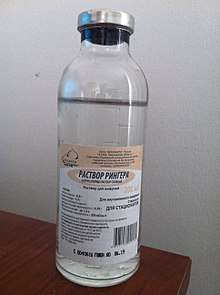Ringer's solution
Ringer's solution is a solution of several salts dissolved in water for the purpose of creating an isotonic solution relative to the body fluids of an animal. Ringer's solution typically contains sodium chloride, potassium chloride, calcium chloride and sodium bicarbonate, with the last used to balance the pH. Other additions can include chemical fuel sources for cells, including ATP and dextrose, as well as antibiotics and antifungals.

Composition
Ringer's solution typically contains NaCl, KCl, CaCl2 and NaHCO3, sometimes with other minerals such as MgCl2, dissolved in distilled water. The precise proportions of these vary from species to species, particularly between marine osmoconformers and osmoregulators.[1][2]
Uses
Ringer's solution is frequently used in in vitro experiments on organs or tissues, such as in vitro muscle testing.[3][4][5][6] The precise mix of ions can vary depending upon the taxon, with different recipes for birds, mammals, freshwater fish, marine fish, etc. It may also be used for therapeutic purposes, such as arthroscopic lavage in the case of septic arthritis.[7][8] Its clinical uses are for replacing extracellular fluid losses and restoring chemical balances when treating isotonic dehydration.[9]
History
Ringer's solution is named after Sydney Ringer, who in 1882–1885 determined that a solution perfusing a frog's heart must contain sodium, potassium and calcium salts in a definite proportion if the heart is to be kept beating for long.[10][11] This solution was adjusted further in the 1930s by Alexis Hartmann, who added sodium lactate to form Ringer's lactate solution.[12]
References
- "COMPENDIA NOTES, PART B: RINGER'S SOLUTIONS". Marine Biological Laboratory. Retrieved 10 June 2018.
- "Table 3. Composition of Ringer's Solution". Research Gate. Retrieved 10 June 2018.
- "What is Ringer's solution?". HydroTherapy. Retrieved 10 June 2018.
- Esen, Ziya; Dikici, Burak; Duygulu, Ozgur; Dericioglu, Arcan F. (20 Jun 2013). "Titanium–magnesium based composites: Mechanical properties and in-vitro corrosion response in Ringer's solution". Materials Science and Engineering: A. 573: 119–126. doi:10.1016/j.msea.2013.02.040.
- Sato, Yusuke; Yamada, Suguru; Takeda, Shigeomi; Hattori, Norifumi; Nakamura, Kae; Tanaka, Hiromasa; Mizuno, Masaaki; Hori, Masaru; Kodera, Yasuhiro (Jan 2018). "Effect of Plasma-Activated Lactated Ringer's Solution on Pancreatic Cancer Cells In Vitro and In Vivo". Annals of Surgical Oncology. 25 (1): 299–307. doi:10.1245/s10434-017-6239-y. PMID 29139022.
- Hongpaisan, J.; Roomans, G. M. (3 Mar 1999). "Retaining ionic concentrations during in vitro storage of tissue for microanalytical studies". Journal of Microscopy. 193 (3): 257–267. doi:10.1046/j.1365-2818.1999.00461.x.
- "Clinical Management of Septic Arthritis in a Sheep: A Case Report". Advances in Animal and Veterinary Sciences. 5 (6): 267–270. July 2017.
- Shinjo, Hirotaka; Nakata, Ken; Shino, Konsei; Hamada, Masayuki; Nakamura, Norimasa; Mae, Tatsuo; Miyama, Takahide; Horibe, Shuji; Yoshikawa, Hideki; Ochi, Takahiro (2002). "Effect of irrigation solutions for arthroscopic surgery on intraarticular tissue: comparison in human meniscus-derived primary cell culture between lactate Ringer's solution and saline solution". Journal of Orthopaedic Research. 20 (6): 1305–1310. doi:10.1016/S0736-0266(02)00062-1. PMID 12472244.
- "Ringers Solution for Infusion". Electronic Medicines Compendium. Retrieved 10 June 2018.
- Hille, Bertil (1984). Ionic Channels of Excitable Membranes. Sunderland, Mass. 01375: Sinauer Associates, Inc. ISBN 978-0-87893-322-8.CS1 maint: location (link)
- Miller, David J. (2004). "Sydney Ringer; physiological saline, calcium and the contraction of the heart". The Journal of Physiology. 555 (3): 585–587. doi:10.1113/jphysiol.2004.060731. PMC 1664856. PMID 14742734.
- Marino, Paul L.; Sutin, Kenneth M. (2012). The ICU Book (3 ed.). Lippincott Williams & Wilkins. p. 363. ISBN 9781451161557.